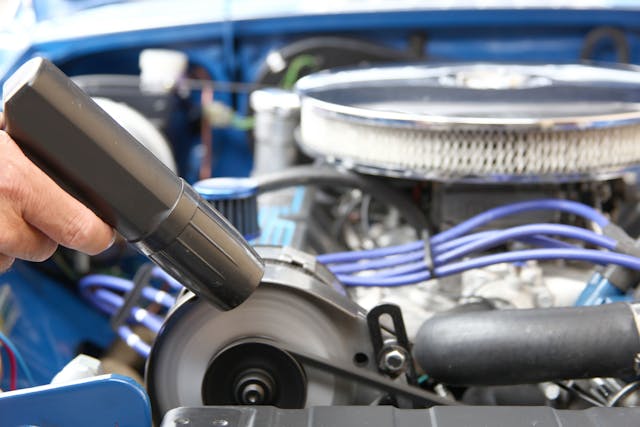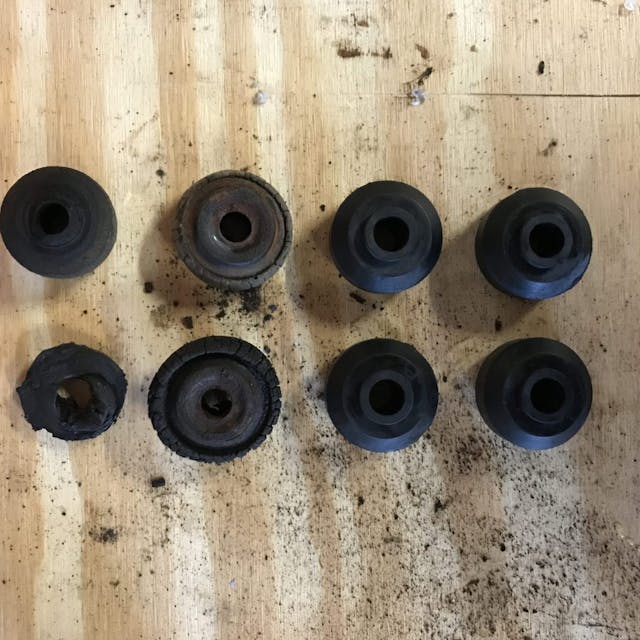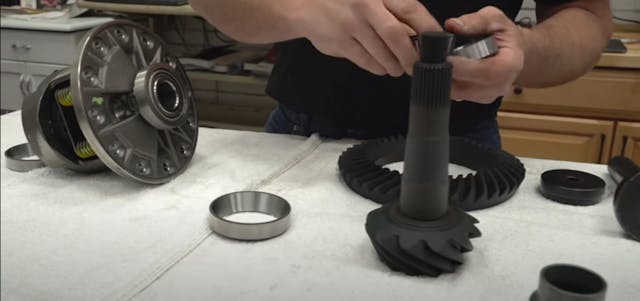6 easy adjustments to change any car’s performance character
We all like to play pretend and be race-car drivers, even when we actually are race-car drivers. Adding a little more aggressive feel to your car’s handling can really enhance the experience of driving, whether you have a modern, four-cylinder boringmobile or a vintage car that you would like to elevate from stylish to focused.
Regardless of your candidate, here are six great places to start dialing up the fun factor of the driving experience. They range from pretty cheap to medium money plus large time investment. Give them a read, and you might just find your next winter project.
Alignment

Production cars balance efficiency with stability, but with a few turns of their tie rods, you can give one a more aggressive personality. Whether you’re looking for quicker turn-in or more stability at high speed, the vast majority of production cars have enough built-in adjustability to accomodate you.
Research how the three options for front-end alignment influence driving feel. (Brush up on the terminology here.) Then contact an alignment shop to get your car dialed-in to your custom specs. The nice thing about this option? The changes are easily reversed.
Ignition timing

Much of engine tuning is based on safety. Not preservation of the occupants’ lives, but the wellbeing of pistons and valves. Factory specs may be conservative, but know that if you push too far on timing it can be an expensive adventure. Proper timing can give you more power, so optimize the ignition timing for your engine modifications. This is especially easy for distributor-equipped engines, but learning to tune with a laptop is not nearly as scary as some would lead you to believe. Classes and tutorials are out there for various programs tailored to modern performance cars.
Suspension bushings

Eliminating play or slop in the pivot points of your suspension will really tighten up the feel of your car. It will also dial the noise, vibration, and harshness up significantly. Fresh rubber bushings go a long way into making a tired car fresh again, and stepping up to polyurethane bushings will produce an even stiffer ride. Be careful here: You may be tempting to put poly bushings everywhere, but those may be overkill for your project or simply ill-suited to your driving habits and local roads. Every type of modification is a compromise; this is one that can be a pain to undo.
Shocks and/or springs

Minimize the body roll of your car and suddenly your car feels ready to take on Le Mans. Well, almost. Many modern cars accomodate bolt-in coilovers that allow for heaps of adjustment and tuning after the fact. For classic rides, you may have to commission custom coil or leaf springs, but the good news is that the work is often more affordable than you might fear. Combine fresh springs with a good set of shocks, and you will find yourself seeking out on-ramps and curvy roads with more confidence than ever.
Gear Ratio

We all want more power—more faster is more better, obviously—but before you flash a moon tune onto your car’s ECU, consider the simpler principle of mechanical advantage. Unless you are at the track regularly, you likely could stand to sacrifice top speed in exchange for better acceleration. Changing the final drive ratio is a prime way to achieve that and is especially straightforward on vintage stick-axle cars. Go ahead and add Positraction while you are in there for extra traction when you need it most.
Weight

Last one, easiest one. A lot of folks will be familiar with the Colin Chapman quote about simplifying and adding lightness, but they may not think about applying it to a car that’s already assembled, and by someone else. If you can tolerate additional NVH (that’s noise, vibration, and harshness in engineer-speak) you can shave pounds by removing insulation or additional fluff from your car. I removed the back seat from my Chevrolet Corvair to shed a little weight. Ounces make pounds, and fewer pounds means faster cars. You can probably keep the Sawzall in the toolbox, though.



When I had my 1954 Mercury 2 door hardtop I replaced the old springs and shocks and replaced the aged rubber bushings with all new polyurethane. It did not turn it into a sports car but made a huge difference in the way it drove and it still had a cushy ride.
Just love your Corvair. Brings back many fond memories of my 1965 Turbo Corsa. And meeting Don Yenko whose dealership did some repairs to mine, and gave my friend and I a ride in one of his Stngers.
My 01 Stang GT looked a lot better and stuck to the road better with wide 20” wheels and tires than with the stock size I ran in the winter, but it was noticeably slower. The weight of the wheels/tires matter.
A lot of folks will be familiar with the Colin Chapman quote about simplifying and adding lightness…
Didn’t work out very well with F1 cars of that era. They crashed and burned a lot.
Alignment, brakes, tires are easy ones.
If the bushings and springs are worn out, replace them first.
Almost all the engines with distributors and carbs can use a better ignition curve. If you run Costco cheap gas, skip to the cosmetic mods. Given most of these factory tunes are a compromise and during the smog era – terrible (at best) recurve the distributor, don’t just bump it as your total timing will be too high.
I run very efficient cooling systems and lower t-stats and coolant temps than most folks in cold places. Given that, I can run a little more timing and a little more compression. Just be careful. There are gains in there, but like others have said – detonation will crack a ring land in short order.
If your compression is low, your engine has a large bore, or both – run more initial. lots more. Heavy cars with Highway gears are more sensitive, light cars with lots deep gears can get away with more.
In a heavy B-body with smallish bore Olds 455 and 3.42s I ran 14* initial with another 20* in the distributor all in by 2800rpm. In a similar weight 455 Buick car with 2.93s, I ran 16* initial and 12* in the distributor. Both got lots if Q-jet love and a performance intake. The olds had headers too. Neither would ping on a 115 degree day or get over 170 degree coolant temp. Mileage went WAY up too. On the 400 Pontiac with a cat converter, I didn’t pull any timing out of the distributor, just bumped it to 14* initial and performed the cooling mods. With 2.41 gears it was slow as a NA diesel, but highway was fun.
Weight does help, especially if trying to achieve balance. But taking A/C out to run a number is dumb if you live in AZ and ever want to drive on the street.
The caveat to ALL of this is in assuming that someone/ anyone knows what they are doing.
Reading through this as a highly experienced mechanic is interesting. O.K. But what I found over the years is that the other 90% would randomly change things based on opinion, feeling or what “somebody said”.
This gets very expensive and can easily lead to serious problems. A common example is wheels & tires.
Many OEM set-ups are fairly well thought out and tested with many thousands of hours of test miles.
I would advise my customers to leave things alone and/ or buy another car that would do what they wanted.
I always hated to see customers waste so much money on ill-advised “alterations” and “performance” work.
John, learn how to spell the name Cragar Wheels. “Krager” is really out there buddy.
Nice to see a white CORSA with red interior again. My ’66 was EXACTLY the same, save for a STEBRO exhaust, quick steering box, and limited slip transaxle (factory… was supposed to be a salesman’s car). Yep, common sense and “little stuff” not forgotten will ALWAYS make the difference. One NOTE: put the spare wheel in the TRUNK – makes the weight distribution better and cushions in case of a crash… Hit a ’67 BUICK with mine (he ran the stopsign)… I drove home; the Buick was totalled!
/classic cars & performance—I think for Most of us who don’t take our cars on racetracks-we just need the bare minimum of “Improvements” so we can keep up with highway traffic– Pushing your engine to the limit will only mean breaking it faster- & playing with excessive power on the street will result in No drivers license pretty fast– wrecking my classic & or losing my license both seem like a Bad Ideal to me-
I just moved the driver’s seat closer to the gas pedal.
All good suggestions, especially the ones about making sure you know what your definition of performance is relative to how you actually use the car and also what your budget is. I’ve found that the online forums for my Pantera are the best ways to find that sweet spot. Others with more experience have already gone through the various upgrades and they are always happy to share what the pros and cons are. Just my 2¢ worth.
Polyurethane sway bar bushings are inexpensive and a huge change to responsiveness. I do this upgrade on every car I have.
Also on older cars going to a lower sidewall height on the tires really helps take away some of the sloppy feel. Cheap too because you can usually find some takeoffs from Craigs list.
I always try to go with factory “plus 1” or “plus 2” wheels.
What about a pair of swaybars (bigger than stock) – this noticeably flattens the cornering. Addco sway bars in Florida has bars for almost all the older cars – https://www.addco.net/
you are right on in terms of tires. A friend owns a large tire shop and fitted 3 different makes to my Aston Martin DB6 Vantage, the differences were amazing. Ended up with Yokohama.
But another big area you’ve missed is the distributor advance curve especially for older cars pre- emission controls. I had a mechanical advance only setup done for a Jag 4.2L motor that completely changed the car for $150 using the original core unit.
With Kyle on five of the six suggestions, but not truckier gearing. That’s what’s tiring about most “muscle cars.” After jerking off at stop lights like a dumb kid trying to impress strangers who could care less, you’re left with a racing engine on the highway. Gearing a car for the one-trick pony of acceleration instead of relaxed cruising seems to us just another symptom of our unwillingness to confront what every poll of scientists shows them agreeing our by far biggest problem, their words, “bigger than climate:”
o v e r p o p u l a t i o n.
You’re either part of the solution, or part of the problem.
Otherwise, like so many lab rats racing nowhere. Some of us prefer what used to be called “road cars,” luxe or not, “distance cars,” or GT, gran turismo cars with more personality than whoa and go, which gets tedious and obnoxious.
surprised you posted a photo of the improper use of a JACK STAND … the silverado pick-up